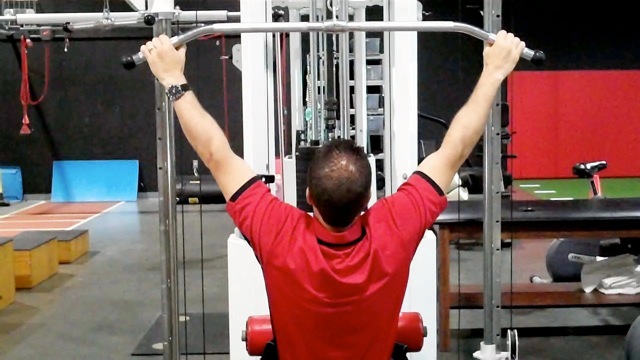
Research has demonstrated that there is contact between the posterior superior labrum and the rotator cuff when the arm is in an abducted and externally rotated position (2,3). Additionally, researchers believe that when the shoulder is placed in a position of abduction and maximal external rotation, the rotation causes a torsional force at the base of the biceps (1).
|
|
While the lat pull-down is not identical to the throwing motion, the shoulder is placed in a similar position during the exercise. It goes without saying that behind the neck pull-downs should never be used as they place the shoulder in the "high five" position which can create anterior shoulder instability. In some cases, it may be necessary to modify in front of the neck pull-downs by altering the load on the shoulder to eliminate pain and relieve stress in certain parts of the movement Consider one of the following modifications with a pull down bar in the face of shoulder pain:
|
|
|
|
Note: Another option would be to choose a neutral grip (palms face in) provided you had access to the appropriate cable attachments. Using this approach would also keep the elbows at the side.
Application:
These modifications are suggestions to allow training to continue provided they do not cause any shoulder pain. Never assume what may be wrong with the shoulder based on the modification that works best. In fact, clients should consult a medical professional for further evaluation if pain or soreness persists with the traditional exercise.
With that said, it is still important to understand how grip width, hand position and lever arms impact the soft tissue and shoulder joint during exercise. Making modifications will protect inflamed tissue and often allow clients to continue training safely in the interim.
These same principles apply to pull-ups as well. However, keep in mind that pull downs allow for reduced and incremental load changes, whereas pull-ups do not unless you are using bands or an assisted machine. Addressing thoracic kyphosis, posterior joint capsule tightness, pec tightness and posterior rotator cuff strength will also help ensure improved mechanics and prevent injuries/pain during overhead lifts.
References:
1. Burkhart SS, Morgan CD. The peel-back mechanism: its role in producing and extending posterior type II SLAP lesions and its effect on SLAP repair rehabilitation. Arthroscopy. 1998;14:637- 640.
2. Jobe CM. Posterior superior glenoid impingement: expanded spectrum. Arthroscopy. 1995;11:530-536.
3. Walch G, Boileau P, Noel E, Donell T. Impingement of the deep surface of the infraspinatus tendon on the posterior glenoid rim. J Shoulder Elbow Surg. 1992;1:238-245.
Brian Schiff, PT, CSCS, is a licensed physical therapist, respected author and fitness professional. Currently, he serves as the supervisor at the Athletic Performance Center in Raleigh, NC. Brian presents nationally at several professional conferences and seminars on injury prevention, rehab and sport-specific training. For more cutting edge training information, subscribe to his monthly Training & Sports Medicine Update at www.BrianSchiff.com.
 Anterior instability also contributes to abnormal glenohumeral motion and strain on the shoulder. Similar to throwing, repetitive lifting with improper form, heavy loads, muscular imbalances, posterior shoulder tightness and bony impingement can lead to an injury over time.
Anterior instability also contributes to abnormal glenohumeral motion and strain on the shoulder. Similar to throwing, repetitive lifting with improper form, heavy loads, muscular imbalances, posterior shoulder tightness and bony impingement can lead to an injury over time. Reduced width overhand grip
Reduced width overhand grip Reduced width supinated grip
Reduced width supinated grip















